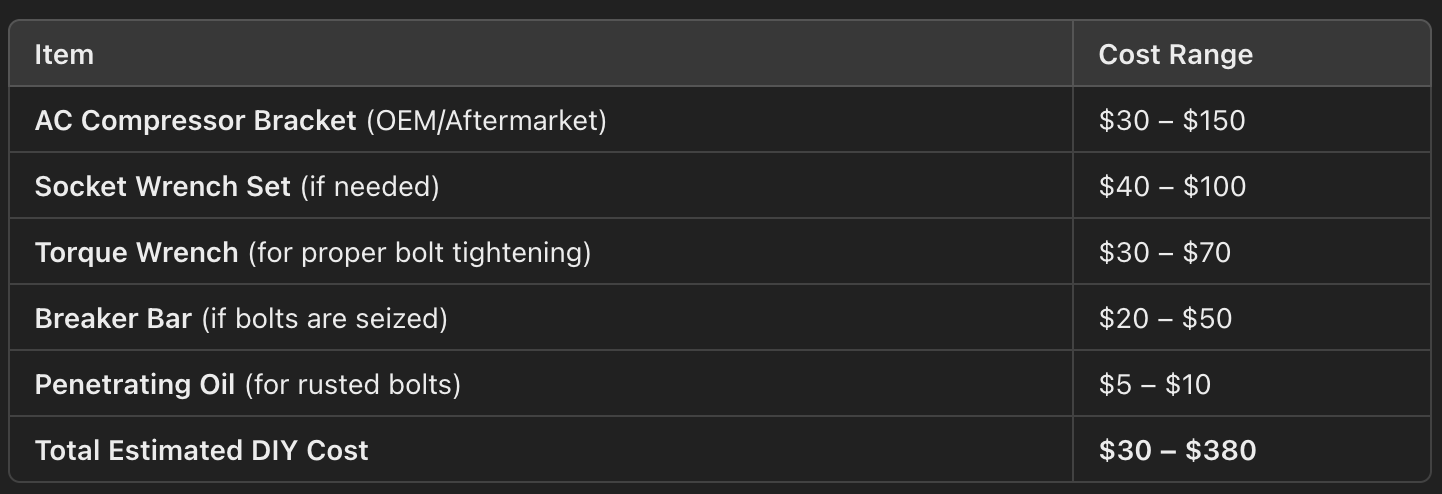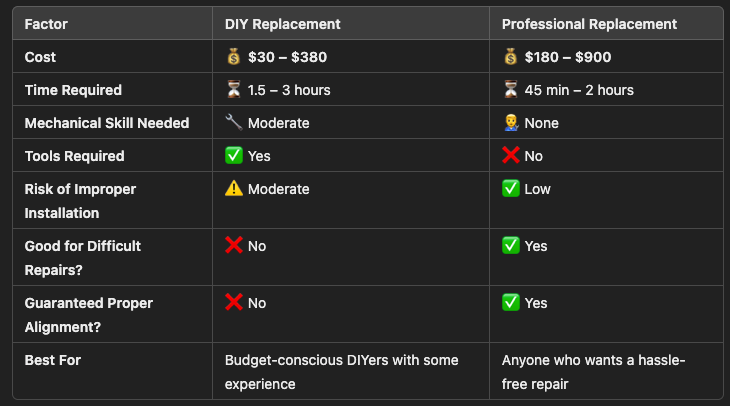OEM Automotive AC Compressor Bracket
OEM AC Compressor Brackets By Vehicle
Find your car manufacturer and or model vehicle you need to find an ac compressor bracket below. We have majority of the automobile listed here to help you locate or narrow down your search. If for any reason you are unable to identify the vehicle you own, please you our instant messenger located to the bottom right of this window. One of our auto part specialist will help you locate the ac compressor bracket you need and get your vehicle in the best running condition!
FAQs about OEM Automotive AC Compressor Brackets
What is an AC compressor bracket, and what does it do?
✅ The AC compressor bracket is a metal mounting component that secures the AC compressor to the engine block or another mounting point.
✅ It maintains proper alignment, prevents vibrations, and supports the compressor’s belt-driven operation.
✅ Without a sturdy bracket, the compressor can shift, leading to belt misalignment, premature wear, and AC failure.
What are the signs of a bad or failing AC compressor bracket?
🚨 Common symptoms include:
✅Rattling or clunking noises from the engine area
✅AC compressor vibrating excessively when the AC is running
✅Uneven or excessive serpentine belt wear
✅The belt slipping off the pulley
✅Visible cracks, rust, or damage on the bracket
✅Loose or missing mounting bolts
✅Frequent AC compressor failures
🛠️ Mechanic Tip: If a vehicle has repeated belt failures or AC issues, check the bracket alignment before replacing the compressor.
Can a loose AC compressor bracket cause AC problems?
Yes! If the bracket is loose, the AC compressor may not engage properly, leading to:
✅Weak or warm air from the vents
Intermittent AC function (cutting in and out)
✅Excessive strain on the AC clutch and pulley
✅Compressor failure due to misalignment
⚠️ Warning: A loose bracket may also cause minor refrigerant leaks at the compressor’s connections.
What causes an AC compressor bracket to fail?
🔧 Common causes include:
✅Normal wear and tear (especially in high-mileage vehicles)
✅Corrosion or rust (in humid or coastal regions)
✅Loose or missing mounting bolts
✅Excessive engine vibrations (bad motor mounts or off-road driving)
✅Accidental impact or improper installation
✅Aftermarket brackets that don’t fit properly
How do I check if my AC compressor bracket is misaligned?
🛠️ Inspection Steps:
1️⃣ Turn off the engine and let it cool.
2️⃣ Visually inspect the bracket for cracks, rust, or loose bolts.
3️⃣ Use a straightedge to check if the compressor is perfectly aligned with the serpentine belt.
4️⃣ Check for belt wear, fraying, or squealing noises.
5️⃣ Start the engine and observe if the compressor wobbles or vibrates excessively.
Can a broken AC bracket affect other engine components?
Absolutely! A misaligned or broken AC bracket can impact:
Serpentine Belt: Excessive wear, slipping, or snapping
Alternator: Improper belt tension can cause charging system issues
Power Steering Pump: Misalignment can lead to steering problems
Water Pump: Over-tensioned or loose belts can cause overheating
⚠️ If left unaddressed, a broken bracket can lead to a major breakdown!
Is it possible to repair a broken AC compressor bracket, or should I replace it?
🛠️ In most cases, replacement is the best option.
If the bracket is cracked or rusted, it is not safe to weld or repair.
If bolts are loose or stripped, retapping the holes may work, but if the bracket is warped, it must be replaced.
🔧 Pro Tip: Always choose a high-quality bracket (OEM or reputable aftermarket brands) to avoid repeat failures.
Can I drive with a broken AC compressor bracket?
⚠️ It is NOT recommended to drive with a broken or loose bracket because:
❌ The serpentine belt may come off while driving, affecting the alternator, power steering, and cooling system.
❌ The AC compressor may seize, leading to a major engine belt failure.
❌ Vibrations and misalignment can cause damage to nearby components.
If you notice bracket failure, get it fixed as soon as possible!
How much does it cost to replace an AC compressor bracket?
💰 Cost estimates depend on the vehicle make/model and labor rates:
DIY replacement: $30–$150 for the bracket + tools if needed
Mechanic repair: $200–$600 (includes labor and potential belt realignment)
If other components (belt, tensioner) are affected: The cost can go up to $1,000+
💡 Tip: Check your vehicle’s OEM bracket price before buying an aftermarket replacement to ensure proper fitment.
How long does it take to replace an AC compressor bracket?
⏳ Time estimate:
DIY repair: 1–3 hours (depending on experience and accessibility)
Professional mechanic: 45 minutes – 2 hours
🚗 What affects the time required?
✅ Engine bay space (Some cars have easy access, others require removing multiple components)
✅ Bolt rust/corrosion (If bolts are seized, extra time is needed)
✅ Serpentine belt routing complexity
Can I replace an AC compressor bracket myself?
Yes, if you have basic mechanical skills!
🛠️ Tools needed:
✅Socket wrench set
✅Torque wrench
✅ Pry bar (for belt tension adjustment)
✅Penetrating oil (if bolts are rusty)
✅Straightedge (to check alignment)
🔧 DIY Tip: Always follow the torque specs in your vehicle’s service manual to avoid over-tightening or under-tightening the bracket bolts.
What’s the best way to prevent AC compressor bracket failure?
📌 Maintenance Tips:
✔ Inspect bolts & bracket during routine oil changes
✔ Check for rust if you live in humid or snowy areas
✔ Avoid cheap, low-quality brackets (stick to OEM or trusted brands)
✔ Replace worn-out motor mounts (to reduce engine vibrations)
✔ Address belt alignment issues early before they cause bracket strain
Are aftermarket AC compressor brackets as good as OEM ones?
✅ It depends on the brand.
Some aftermarket brackets are high-quality and perform well.
Others don’t fit perfectly, leading to alignment issues and potential damage.
🔎 How to choose a good aftermarket bracket:
✔ Check customer reviews for your vehicle model
✔ Compare material quality (Aluminum, Steel, Cast Iron)
✔ Ensure proper bolt hole alignment before installation
✔ Choose reputable brands (Dorman, Motorcraft, ACDelco, Gates, Dayco)
What Mechanics and Owners Need to Know About AC Brackets
The ac compressor bracket is one of those components that most vehicle owners never think about—until something goes wrong. Whether you're an auto mechanic diagnosing ac issues or a regular vehicle owner looking for maintenance tips, understanding the hidden problems and best repair practices can help you prevent costly repairs and improve ac performance.
Replacing an AC compressor bracket is an important repair that affects not only the air conditioning system but also belt alignment and overall engine performance.
- DIY replacement can save money, but it requires mechanical skills, patience, and the right tools.
- Professional replacement is faster and ensures proper alignment, but it costs significantly more.
Auto Mechanics: Common AC Bracket Issues & Diagnostic Hacks
Mechanics need to be aware of AC compressor bracket-related issues because a failing bracket can mimic other AC problems. Here’s how to diagnose, repair, and troubleshoot bracket failures efficiently.
1. AC Compressor Failure Could Be a Bracket Issue (Hidden Problem)
- Symptoms of a failing AC compressor (grinding noises, clutch issues, misalignment) can sometimes be traced back to a loose, broken, or misaligned bracket.
- A misaligned bracket puts strain on the compressor, causing early failure.
- Mechanics should always inspect the bracket before replacing the compressor—it could save customers from expensive, unnecessary repairs.
Source #1: CarTalk
Source #2:
How to Diagnose AC Compressor Problems - YourMechanic
2. Belt Wear and Slipping: Bracket Alignment is Key
- Many mechanics immediately suspect a bad serpentine belt or tensioner when they see uneven belt wear or hear belt squealing.
- However, if the bracket is bent or cracked, it can throw off pulley alignment, leading to premature belt wear and belt slippage.
- Mechanic Hack: Before replacing a belt, use a straightedge tool to check pulley alignment. If misalignment is detected, inspect the bracket for damage.
Source #1: Diagnosing Serpentine Belt Noise & Misalignment - Gates
Source #2: Dayco Tech Tips
3. The ‘Mystery AC Leak’ That Might Not Be a Leak
- If an AC system is losing refrigerant, mechanics usually check for hose leaks or a bad compressor.
- However, a loose AC compressor bracket can cause the compressor to shift ever so slightly, leading to small refrigerant leaks at the connection points.
- Mechanic Hack: If you suspect a leak but can't find one,
manually wiggle the compressor to see if it shifts. If there’s movement, tighten or replace the bracket before assuming a compressor or refrigerant issue.
Source:
4. Diagnosing Noisy Vibrations: Bracket & Bushing Issues
- If a customer complains about a rattling noise from the AC, a common assumption is a failing compressor clutch or pulley.
- However, loose mounting bolts or damaged bushings on the AC bracket can cause excessive vibrations.
- Mechanic Hack: If you hear a rattle, check the compressor mounting bolts and the bracket bushings. Tightening or replacing these could solve the problem without needing a new compressor.
Source:
5. Aftermarket Bracket Fitment Issues
- When replacing an AC compressor bracket, some mechanics go for cheaper aftermarket brackets.
- The problem? Some aftermarket brackets are slightly off in size, which can lead to poor compressor alignment.
- Mechanic Hack: Always compare the old and new bracket side by side before installation. If bolt holes are even slightly off, adjustment washers or a custom spacer may be needed to ensure proper alignment.
Source:
Regular Vehicle Owners: What You Need to Know About the AC Bracket
For everyday drivers, understanding how the AC compressor bracket affects the air conditioning system can help prevent expensive AC repairs. Here’s what every vehicle owner should know:
1. Your AC Compressor Might Not Be the Problem
- If your AC suddenly stops working, mechanics may suggest a costly compressor replacement.
- However, if the bracket is loose or broken, the compressor may not be functioning properly, even if it's still in good condition.
- Owner Tip: If your mechanic suggests a compressor replacement, ask them to check the bracket first—this could save you hundreds of dollars.
Source #1: Gates Belts and Hoses Guide
Source #2:
Dayco Serpentine Belt Diagnostics
2. AC Bracket Failure Can Cause Your Belt to Snap
- If you’ve ever had a serpentine belt snap unexpectedly, the issue might not have been the belt itself.
- A damaged bracket can cause the compressor to shift, which leads to excessive tension on the belt.
- Owner Tip: If you’ve had to replace a belt multiple times, have a mechanic inspect the AC bracket and compressor alignment.
Source #1: Diagnosing Serpentine Belt Noise & Misalignment - Gates
Source #2: Dayco Tech Tips
3. A Bent AC Bracket Can Affect Engine Performance
- The AC compressor bracket isn’t just about the AC system—it can also affect engine performance.
- If the bracket is misaligned, it can cause the serpentine belt to run unevenly, affecting the alternator, power steering, and water pump.
- Owner Tip: If you notice
electrical issues, power steering problems, or overheating, don’t overlook the
AC bracket as a possible culprit.
Source: AutoZone Repair Guides
4. Engine Vibrations Can Break the AC Bracket Over Time
- High-mileage vehicles and trucks that experience heavy vibrations can develop cracks in the AC bracket over time.
- If the bracket breaks completely, it could lead to a sudden failure of the AC system.
- Owner Tip: If you drive a work truck, off-road vehicle, or older car, inspect the AC compressor bracket for cracks as part of routine maintenance.
Source #1: iATN (International Automotive Technicians Network)
Source #2: AA1Car AC System Noise & Vibrations
5. Rust and Corrosion Can Weaken the Bracket
- In areas with high humidity or road salt exposure, steel AC brackets can rust over time.
- A rusted bracket can weaken, eventually causing the compressor to shift or fall out of alignment.
- Owner Tip: If you live in a humid or snowy climate, check for rust buildup around the AC compressor mount and replace the bracket if it looks corroded.
Source #1: Eastwood Rust Prevention Guide
Source #2:
Krown Rust Protection
DIY vs. Professional AC Compressor Bracket Replacement
DIY Step-by-Step Guide to Replacing an AC Compressor Bracket
🛠 Tools Required:
- Socket wrench set
- Torque wrench (for proper bolt tightness)
- Pry bar (for belt tension adjustment)
- Penetrating oil (for rusted bolts)
- Straightedge (to check belt alignment)
Step-by-Step Instructions:
- Turn Off the Engine & Disconnect the Battery – Prevents electrical shocks.
- Release Belt Tension – Use a wrench on the tensioner pulley to remove the serpentine belt.
- Remove AC Compressor Mounting Bolts – Carefully support the compressor to avoid damage.
- Unbolt the Old Bracket – Remove the damaged bracket from the engine block.
- Install the New Bracket – Align the new bracket properly and tighten bolts to manufacturer specifications.
- Reinstall AC Compressor – Secure the compressor in place.
- Reinstall Serpentine Belt – Ensure proper belt tension and alignment.
- Reconnect Battery & Start Engine – Run the AC and check for noise, vibration, or misalignment.
⏳ Estimated DIY Time: 1.5 – 3 hours (varies by vehicle)
⚠️ Warning: Misalignment can cause belt wear, compressor failure, and even engine performance issues. Always follow torque specs!





